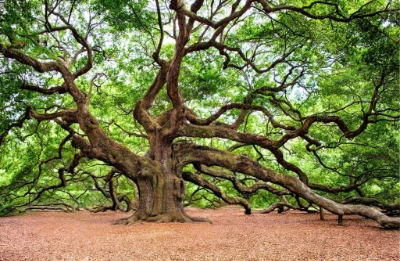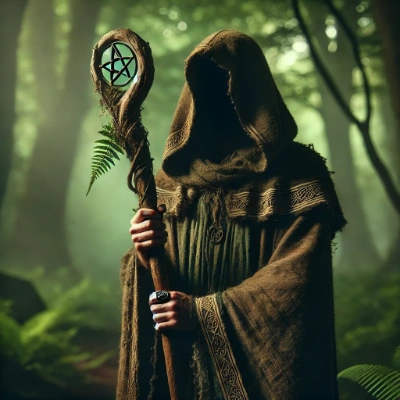The Story of Trefuilngid Tre-eochair
Ireland’s folklore is brimming with legendary heroes, magical realms, and ancient wonders. Yet one mysterious figure, Trefuilngid Tre-eochair, remains relatively unknown despite his remarkable role in shaping the island’s sacred landscape. According to certain medieval Irish traditions, Trefuilngid arrived on Irish shores bearing seeds of otherworldly trees—seeds that would root themselves as the famed Five Great Trees, the Sacred Trees of Ireland.
This post will explore who Trefuilngid Tre-eochair is, how he is connected to the sacred trees of Irelanbd, and why these legends remain significant in Ireland’s cultural tapestry.
Table of Contents
Sacred Trees in Irish Lore

Trees in Celtic Culture
Trees held a profound place in Celtic society. Oaks and yews were revered for their longevity and the shelter they provided to people and wildlife. They also connected the physical world to the Otherworld, the mystical realm interweaving with everyday reality in Irish myth.
The Five Great Trees
Throughout Irish lore, we find references to enormous, revered trees said to mark tribal boundaries, host royal assemblies, or serve as spiritual gathering points. Though the exact lists differ, many sources identify five core trees:
- Eó Mugna
- Bile Tortan
- Eó Rossa
- Craeb Uisnig (or Bile Uisnig)
- Craeb Dathi (occasionally replaced by other names)
Said to be of colossal height and endowed with magical qualities, these trees symbolized Ireland’s unity, the sanctity of nature, and the sovereignty of its rulers.
Sources & Variations
These legendary trees surface in medieval Irish dindshenchas (place-lore) texts and poetic traditions. Because references are scattered and sometimes inconsistent, the precise details—names, locations, powers—can vary from one manuscript to another.
Who Is Trefuilngid Tre-eochair?
Trefuilngid Tre-eochair is one of those mythic personalities who appear in the margins of Irish texts rather than in well-known cycles like the Ulster or Fenian Cycles. He is often described as a druid, sage, or supernatural teacher, carrying knowledge from another realm.
Name & Etymology
The spelling of his name varies—”Trefuilngid,” “Trefuilngi,” and “Tre-eochair” are among the forms found in manuscripts. Scholars have speculated about possible meanings, suggesting “three keys” or “threefold knowledge,” but no consensus exists.
Role in Mythology

Although scarce, the references to Trefuilngid underline a figure who arrives at a pivotal location (often the Hill of Tara) to reveal wisdom—sometimes the Ogham writing system—and to plant or distribute seeds that become Ireland’s most hallowed trees.
The Arrival of Trefuilngid in Ireland
Tara as the Heart of Ireland
In Irish tradition, the Hill of Tara was the ceremonial seat of Ireland’s High Kings. It was a place where political power intersected with the island’s spiritual dimension. Trefuilngid’s arrival here highlights the centrality of Tara to Ireland’s mythic landscape.
Seeds of the Sacred Trees
One of the most intriguing legends claims that Trefuilngid came bearing seeds (or cuttings) from a faraway, possibly Otherworldly source. He then planted these seeds himself or entrusted them to local kings and druids, ensuring that each province of Ireland received a sacred tree. This act can be seen as mystically unifying the land and conferring spiritual protection.
Teaching Ogham
In some accounts, Trefuilngid also imparts knowledge of the Ogham script, Ireland’s earliest form of writing. By linking him to literacy and learning, these tales further stress his image as a divine teacher—one who endows Ireland with living symbols of sovereignty and the tools of written language.
Otherworldly or Angelic Influences
Because many of these tales were preserved by Christian monks, it’s not unusual to find Christianized versions. Trefuilngid may be depicted akin to an angelic or saintly figure, aligning with the broader medieval tendency to blend pagan lore with Christian themes.
Significance of the Myth
Symbol of Sovereignty & Unity
Planting sacred trees in each province underscores a powerful metaphor for Ireland’s unity. In ancient times, trees often represented a community’s bile, or “sacred centre,”. By installing (or bestowing) these trees, Trefuilngid helps knit the land together under one spiritual canopy—a crucial element in consolidating royal authority and national identity.
Wisdom & Writing
The tradition that Trefuilngid introduced or explained to Ogham signifies that writing was perceived as magical, mysterious, and potentially divine. This lore emphasizes the cultural reverence for knowledge, letters, and the craft of poetry—all hallmarks of an educated and spiritually aware society.
Landscape as Mythic Canvas
Irish mythology often presents the land as shaped by heroic or otherworldly forces: lakes, mountains, or trees can all have stories behind their existence. By linking these Five Great Trees directly to a visit from a mysterious figure, the myths enchant the countryside, reminding us of a time when the boundary between everyday life and the Otherworld was far more permeable.
Variation in the Stories
Scattered References
Like many figures in Irish lore, Trefuilngid doesn’t have a comprehensive saga. Instead, he appears in commentaries on Ogham, fragments of dindshenchas, or genealogical texts. Each mention may offer a slightly different perspective.
Local Folklore Spin-Offs
Over centuries, local legends might substitute different tree names or relocate them to suit a region’s pride, often connecting them to holy wells or saints. In these ways, Trefuilngid’s story continues to evolve, weaving itself deeper into Ireland’s patchwork of localized myth.
Modern Interpretations
Today, various authors and spiritual practitioners draw on Trefuilngid’s legend. Some regard him as a symbol of ecological guardianship. In contrast, others see him as an embodiment of Ireland’s ancient wisdom traditions. In any case, the ongoing interest underscores the myth’s enduring resonance.
Recap
Trefuilngid Tre-eochair stands at the crossroads of Irish myth, planting the seeds that would grow into the Five Great Trees and teaching the knowledge of Ogham. His presence at Tara—a spiritual and political nucleus—frames him as a figure who profoundly changes Ireland’s cultural and physical landscape.
Why It Matters Today
These stories remind us of an age when nature, culture, and spirituality were intertwined. They invite reflection on our relationships with the land and the cultural narratives we pass down. Trefuilngid’s tale of sacred trees and treasured knowledge resonates as a call to reverence, stewardship, and unity in a world often disconnected from nature.
Invitation to Further Exploration
If you’re fascinated by Irish legends, consider seeking out the dindshenchas (place-lore) poems or studying the Auraicept na n-Éces (The Scholars’ Primer) to learn more about Ogham. Visiting sites associated with ancient trees (even if only symbolic descendants remain) can provide a tangible link to these rich myths and Ireland’s unbroken storytelling tradition.
- References / Further Reading
- Lebor Gabála Érenn (Book of Invasions) – Though it doesn’t directly focus on Trefuilngid, it outlines Ireland’s mythic waves of settlers, offering a broader context.
- Dindshenchas (Place-Lore) – Medieval texts preserving stories of sacred sites, including the Five Great Trees.
- Auraicept na n-Éces (The Scholars’ Primer) – A fundamental resource on Ogham, which some traditions link to Trefuilngid’s teaching.
- Carey, John. The Irish National Origin-Legend: Synthetic Pseudohistory. Dublin Institute for Advanced Studies, 1994.
- Ó Duinn, Seán. Where Three Streams Meet: Celtic Spirituality. The Columba Press, 2002.
In the legends of Trefuilngid Tre-eochair, we see a compelling blend of myth, mysticism, and cultural identity—an enduring narrative of Ireland’s connection to the land, its language, and its shared heritage.
